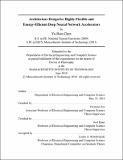| dc.contributor.advisor | Vivienne Sze and Joel Emer. | en_US |
| dc.contributor.author | Chen, Yu-Hsin, Ph. D. Massachusetts Institute of Technology | en_US |
| dc.contributor.other | Massachusetts Institute of Technology. Department of Electrical Engineering and Computer Science. | en_US |
| dc.date.accessioned | 2018-09-17T14:51:48Z | |
| dc.date.available | 2018-09-17T14:51:48Z | |
| dc.date.copyright | 2018 | en_US |
| dc.date.issued | 2018 | en_US |
| dc.identifier.uri | http://hdl.handle.net/1721.1/117838 | |
| dc.description | Thesis: Ph. D., Massachusetts Institute of Technology, Department of Electrical Engineering and Computer Science, 2018. | en_US |
| dc.description | This electronic version was submitted by the student author. The certified thesis is available in the Institute Archives and Special Collections. | en_US |
| dc.description | Cataloged from student-submitted PDF version of thesis. | en_US |
| dc.description | Includes bibliographical references (pages 141-147). | en_US |
| dc.description.abstract | Deep neural networks (DNNs) are the backbone of modern artificial intelligence (AI). However, due to their high computational complexity and diverse shapes and sizes, dedicated accelerators that can achieve high performance and energy efficiency across a wide range of DNNs are critical for enabling AI in real-world applications. To address this, we present Eyeriss, a co-design of software and hardware architecture for DNN processing that is optimized for performance, energy efficiency and flexibility. Eyeriss features a novel Row-Stationary (RS) dataflow to minimize data movement when processing a DNN, which is the bottleneck of both performance and energy efficiency. The RS dataflow supports highly-parallel processing while fully exploiting data reuse in a multi-level memory hierarchy to optimize for the overall system energy efficiency given any DNN shape and size. It achieves 1.4x to 2.5x higher energy efficiency than other existing dataflows. To support the RS dataflow, we present two versions of the Eyeriss architecture. Eyeriss v1 targets large DNNs that have plenty of data reuse. It features a flexible mapping strategy for high performance and a multicast on-chip network (NoC) for high data reuse, and further exploits data sparsity to reduce processing element (PE) power by 45% and off-chip bandwidth by up to 1.9x. Fabricated in a 65nm CMOS, Eyeriss v1 consumes 278 mW at 34.7 fps for the CONV layers of AlexNet, which is 10x more efficient than a mobile GPU. Eyeriss v2 addresses support for the emerging compact DNNs that introduce higher variation in data reuse. It features a RS+ dataflow that improves PE utilization, and a flexible and scalable NoC that adapts to the bandwidth requirement while also exploiting available data reuse. Together, they provide over 10x higher throughput than Eyeriss v1 at 256 PEs. Eyeriss v2 also exploits sparsity and SIMD for an additional 6x increase in throughput. | en_US |
| dc.description.statementofresponsibility | by Yu-Hsin Chen. | en_US |
| dc.format.extent | 147 pages | en_US |
| dc.language.iso | eng | en_US |
| dc.publisher | Massachusetts Institute of Technology | en_US |
| dc.rights | MIT theses are protected by copyright. They may be viewed, downloaded, or printed from this source but further reproduction or distribution in any format is prohibited without written permission. | en_US |
| dc.rights.uri | http://dspace.mit.edu/handle/1721.1/7582 | en_US |
| dc.subject | Electrical Engineering and Computer Science. | en_US |
| dc.title | Architecture design for highly flexible and energy-efficient deep neural network accelerators | en_US |
| dc.type | Thesis | en_US |
| dc.description.degree | Ph. D. | en_US |
| dc.contributor.department | Massachusetts Institute of Technology. Department of Electrical Engineering and Computer Science | |
| dc.identifier.oclc | 1052123991 | en_US |
